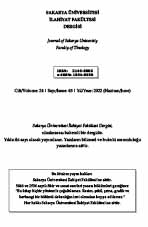Büyük Selçukluların Yıkılışından Moğol İstilasına Kadar Eşarîliğin Durumu
The Status of The Ash‛arism From The Destruction of The Great Seljuk to The Mongolic Invasion
Author(s): Abdullah Ömer YavuzSubject(s): Cultural history, Political history, Theology and Religion, Islam studies, History of Religion
Published by: Sakarya üniversitesi
Keywords: History of Islamic Sects; Politics; Ash‛arism; Khwārizm; Gūr;
Summary/Abstract: The historical adventures of the sects, which are Islamic schools of thought, have a complex plane that includes different orientations rather than simple and one-way directions. Understanding and correctly interpreting this multi-layered factual dimension requires multiple perspectives, like the variable leg of the compass. As of their historical processes, sects determine their positions depending on political, economic, social, etc. This position draws a route according to its positive or negative relations with its interlocutors. Intellectual debates and works of rejection are the outward manifestations of the interlocutor. It is a common acceptance to try to explain the progress of Ash‛arī thought by centering on the Great Seljuks and Nizamiyyāh madrasahs. This research examines the historical development of Ash‛arism by focusing on the period after the collapse of the Great Seljuks. As it is known, in the Great Seljuk period, the relationship of Ash‛arism with the state did not have a linear progression, but with the support of the state, it had a position that paved the way for it. After the collapse of the Great Seljuks, political conflicts, wars, invasions and plunders increased in the region, causing a great chaos in the region.
Journal: Sakarya Üniversitesi İlahiyat Fakültesi Dergisi (SAUIFD)
- Issue Year: 24/2022
- Issue No: 45
- Page Range: 165-184
- Page Count: 20
- Language: Turkish

